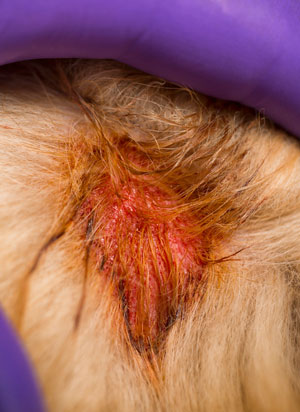Contact Dermatitis in Dogs

There are many reasons for dogs to develop skin rashes or to begin licking and scratching at their bodies. One of these is contact dermatitis.
What Is Canine Contact Dermatitis?
Contact dermatitis happens when your dog comes into direct contact with something that irritates his skin. Often, this is a chemical, but it can also happen if a dog is allergic to something that touches him, such as laundry detergents.
Dogs don't generally have allergic reactions to poison ivy, oak, or sumac. However, they can carry the oil on their coats and spread it to humans, who most likely will have an allergic skin reaction to it.
Contact dermatitis may result in mechanical burning of or irritation to the skin. It may also cause a local allergic reaction.
Symptoms of Contact Dermatitis in Dogs
Dogs that have a reaction to something that has touched their skin may develop some or all of the following signs:
- Skin redness
- Localized hair loss
- Licking
- Scratching
- Rash
Moist eczema, or a hot spot, can develop from contact dermatitis.
It's important to note that the same signs can be shown by a dog with many other conditions, such as inhaled allergies, food allergies, flea allergies, or mite or ringworm infection.
How Is Contact Dermatitis in Dogs Diagnosed?
It might not be easy to diagnose contact dermatitis in a dog because other conditions can result in the same signs. Sometimes a diagnosis is only made after a dog has had recurring episodes of the condition and the owner or veterinarian notices a pattern.
Other times, such as when your dog comes into contact with spilled chemicals in your home, the cause is obvious.
Treatment of Canine Contact Dermatitis
Treatment of this skin condition may include washing the area copiously with water if a chemical has been contacted, shaving the area and cleaning it, antibiotics if there is a secondary infection, topical creams with antihistamine or steroid in them, and oral medication.
The exact treatment that your dog requires will need to be determined by your veterinarian after a thorough examination.
Learn about first aid for dogs exposed to chemicals here: "First Aid for Chemical Burns in Dogs."
Is My Dog Normal? 15 Dog Behaviors Explained - Slideshow
Dog Fleas: How to Look for Fleas on Your Dog
Otitis Externa: Ear Infections in Dogs
Apple Cider Vinegar as Flea Control for Dogs
Lick Granuloma: Causes, Treatments, and Prevention of Acral Lick Granuloma in Dogs
Disclaimer: This website is not intended to replace professional consultation, diagnosis, or treatment by a licensed veterinarian. If you require any veterinary related advice, contact your veterinarian promptly. Information at DogHealth.com is exclusively of a general reference nature. Do not disregard veterinary advice or delay treatment as a result of accessing information at this site. Just Answer is an external service not affiliated with DogHealth.com.
Notice: Ask-a-Vet is an affiliated service for those who wish to speak with a veterinary professional about their pet's specific condition. Initially, a bot will ask questions to determine the general nature of your concern. Then, you will be transferred to a human. There is a charge for the service if you choose to connect to a veterinarian. Ask-a-Vet is not manned by the staff or owners of DogHealth.com, and the advice given should not delay or replace a visit to your veterinarian.



